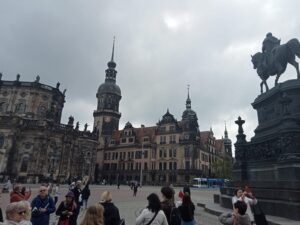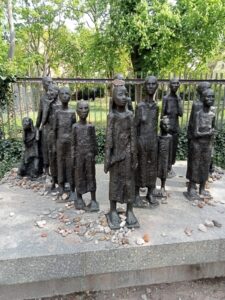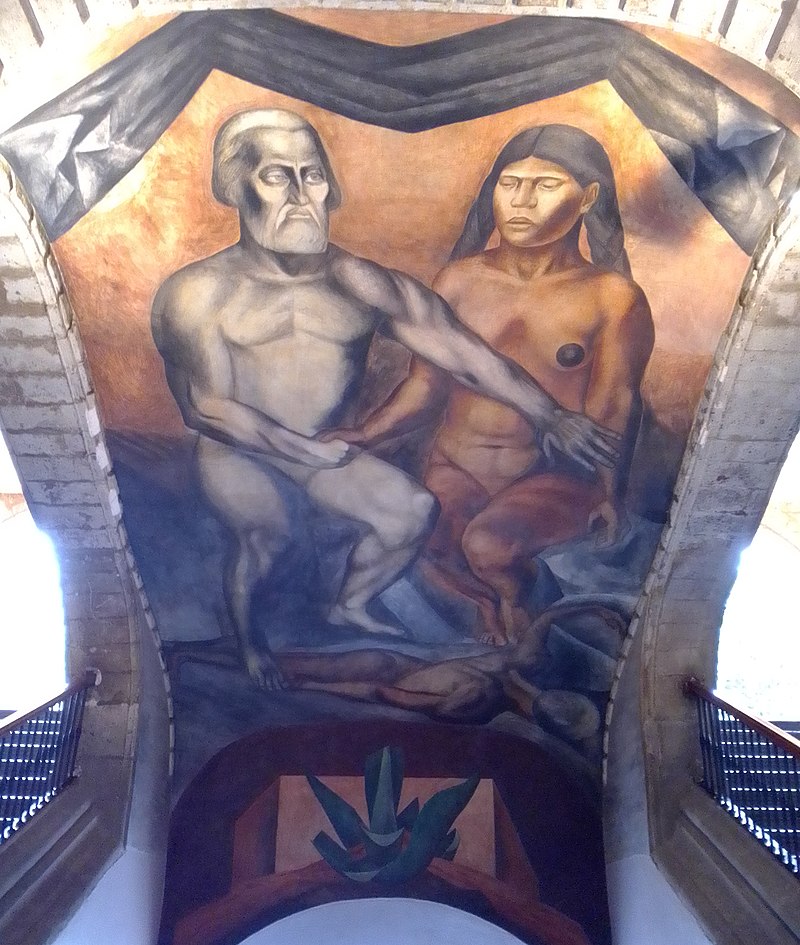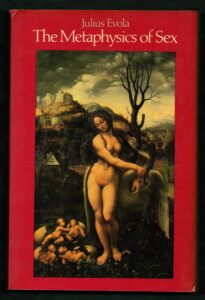Lebenskraft ! (2)
Dresden
25 April
One would think that, if political correctness reigns in Berlin, at least in Dresden, the archetypal object of the fury of the Hellstorm Holocaust where whole families of Germans were incinerated, the locals would be more conscious. But in my brief stay in the city the diametrically opposite was true…
Arriving in the former capital of Saxony, on the banks of the Elbe River, the capital of Germanic culture and considered the most beautiful city in eastern Germany, the bells of the huge Lutheran church, now completely rebuilt, were ringing. I was annoyed that the Germans had rebuilt the Frauenkirche between 1994 and 2005 because it was precisely this reforming monk, Luther, who had introduced the Old Testament into the Aryan collective unconscious.
What struck me about the central square was a great secular contrast to the church of the former Augustinian monk: the Semper Opera House, partially destroyed in 1945 until it was painstakingly rebuilt in 1986. (Before its destruction, some of Germany’s greatest operas had been performed here, three by Richard Wagner and most of Richard Strauss.) I was struck by the bronze statue above the portico depicting Dionysus and Ariadne on a chariot of panthers—pre-Christian culture! Next to the entrance we can make out the sculptures of Goethe and Schiller in this photo I took:
There were several tours in the central square. The one I followed was led by a native German with a Scandinavian name, Björn, who spoke good Spanish, having married a Galician. As I recall, we started from the equestrian sculpture in the centre of the square.
I said above that the opposite of what I expected happened to me, in the sense that one would expect a resident of Dresden to have, at least, some awareness of Allied evil during the Hellstorm fire.
When, together with the tour group, I brought up the recent Israeli bombing of Gaza and compared it to Dresden in 1945, Björn blushed greatly! So much so that he felt compelled to launch into a little pious speech pointing out that, after the Holocaust, the German government was very sensitive about the Jewish issue. His behaviour reminded me of those who equate criticism of Israel with anti-Semitism. Björn merely repeated the talking points of his country’s political correctness instead of answering what I said: that in 1945 Dresden was left as Gaza was recently (actually much worse, given the number of German civilians holocausted by the bombings).
It is worth analysing why Björn got so freaked out by such a seemingly innocent remark.
In my recent essay on Augustine, Goethe and others, I talked about how Augustine’s devouring mother instilled in her adolescent son an evil introject that made him feel tremendously guilty about his nascent erotic impulses. Well, well… An evil introject can also be instilled by the persistent propaganda of a powerful state, especially if the propaganda is repeated over several generations. For the Greeks and Romans sexuality wasn’t sinful. That changed after the reigns of Constantine and the Christian emperors. Remember Nietzsche, Christianity gave Eros poison to drink; he did not die but degenerated into vice.
Similarly, for eighty years Western governments and the Jewish media apparatus (including Hollywood) have made us see the Third Reich as the new Satan, and almost all of us in the West internalised the propaganda, to some extent, at some point in our lives. But in Germany the hammering of such propaganda has been as insidious as Monica’s constant haranguing of young Augustine to become a champion of Constantine’s religion. In my essay I called this an ‘ogre of the superego’.
Our guide in Dresden, Björn, also suffers from an ogre of the superego, which in Christendom is equivalent to Augustine’s ogre of the superego about Eros. And yet Björn told us a story of incredible betrayal by the German government: the relatively recent theft from a museum we visited of pieces worth millions of euros. The sandniggers who stole them will soon go free—and rich! (they only returned half of what they stole).
This anecdote that the poor devil Björn told us, his Aryan pride crushed by an ogre of the superego, reflects the anti-Nazi Germany of our times: we must love our enemies and pray for those who persecute us. Good neochristians! The unconscious ogre that inhabits Björn was also noted in the fact that some sources on the attack on Dresden put the death toll between three and four hundred thousand. Björn, an ethnic German living in the city, said that only 25,000 had died and that the rest was ‘Nazi propaganda’.
At the end of his tour of Dresden’s now reconstructed buildings, I asked Björn what had haunted me in Berlin: If there is an equivalent of pubs in Germany, where I could approach perfect strangers in Dresden—native Germans—to talk to them about important matters. His answer, or rather non-answer, surprised me a lot!
He simply told me that he had to give another tour and that he had no more time. But answering such a simple question—remember what the woman in the hotel lobby in Berlin told me—wouldn’t have taken more than a few seconds. So I was left wanting to talk to Aryan men in the second German city I visited after an answer that wasn’t an answer at all.
In a sense I understand Björn. One can imagine asking a question about the Gulag to a Russian tour guide in Brezhnev’s time. But in his case I got the strong impression that Björn had internalised with extraordinary ferocity the narrative the government tells its citizens (as Augustine fiercely internalised the anti-erotic injunctions of his ultra-Christian mother).
After Björn said goodbye it was a little chilly and I took refuge in a café with large shop windows to watch the passers-by. Although many were tourists visiting Dresden, I guess there were also Germans among them. It seemed to me that these white people were shabby, like in spaghetti westerns where you don’t get good-looking actors like Hollywood actors. They were very different from the 1930s Berlin video I linked in my previous post, and I was also surprised to see that many of them were walking around eating ice cream. For about an hour I watched them from the vantage point of my cafe with the large display cases (I wasn’t wearing a jacket for the cold because the weather in Berlin had been warmer).
The saddest thing of all is that, to save the Aryan from his current psychosis—being utterly possessed by the Jewish collective unconscious—it will be necessary for someone like Kalki to destroy the rebuilt Frauenkirche again…
















